Telehealth in Singapore: Impact on Healthcare and Future Trends
VerifiedAdded on 2020/02/24
|19
|5671
|82
Report
AI Summary
This report provides a comprehensive analysis of telehealth in Singapore, exploring its implementation, benefits, and challenges within the healthcare system. It examines the use of telehealth technologies, such as remote consultations and robotic surgery, and how these innovations support patients. The report details the advantages of telehealth, including increased access to care, reduced travel costs, and improved efficiency for healthcare providers. It also addresses the challenges, such as patient unfamiliarity with technology and concerns about remote monitoring. Furthermore, the report discusses Singapore's initiatives to integrate telehealth, including the development of smart hospitals and the use of the National Electronic Health Record (NEHR) system. It also highlights the role of telehealth in addressing the challenges of an aging population and the rise of chronic diseases, with a focus on palliative care and personal health management. The report emphasizes the potential of telehealth to optimize resources, improve patient outcomes, and transform the healthcare landscape in Singapore.

Running head: TELEHEALTH IN SINGAPORE
Telehealth in Singapore
Name of the Student
Name of the Author
Author Note
Telehealth in Singapore
Name of the Student
Name of the Author
Author Note
Paraphrase This Document
Need a fresh take? Get an instant paraphrase of this document with our AI Paraphraser
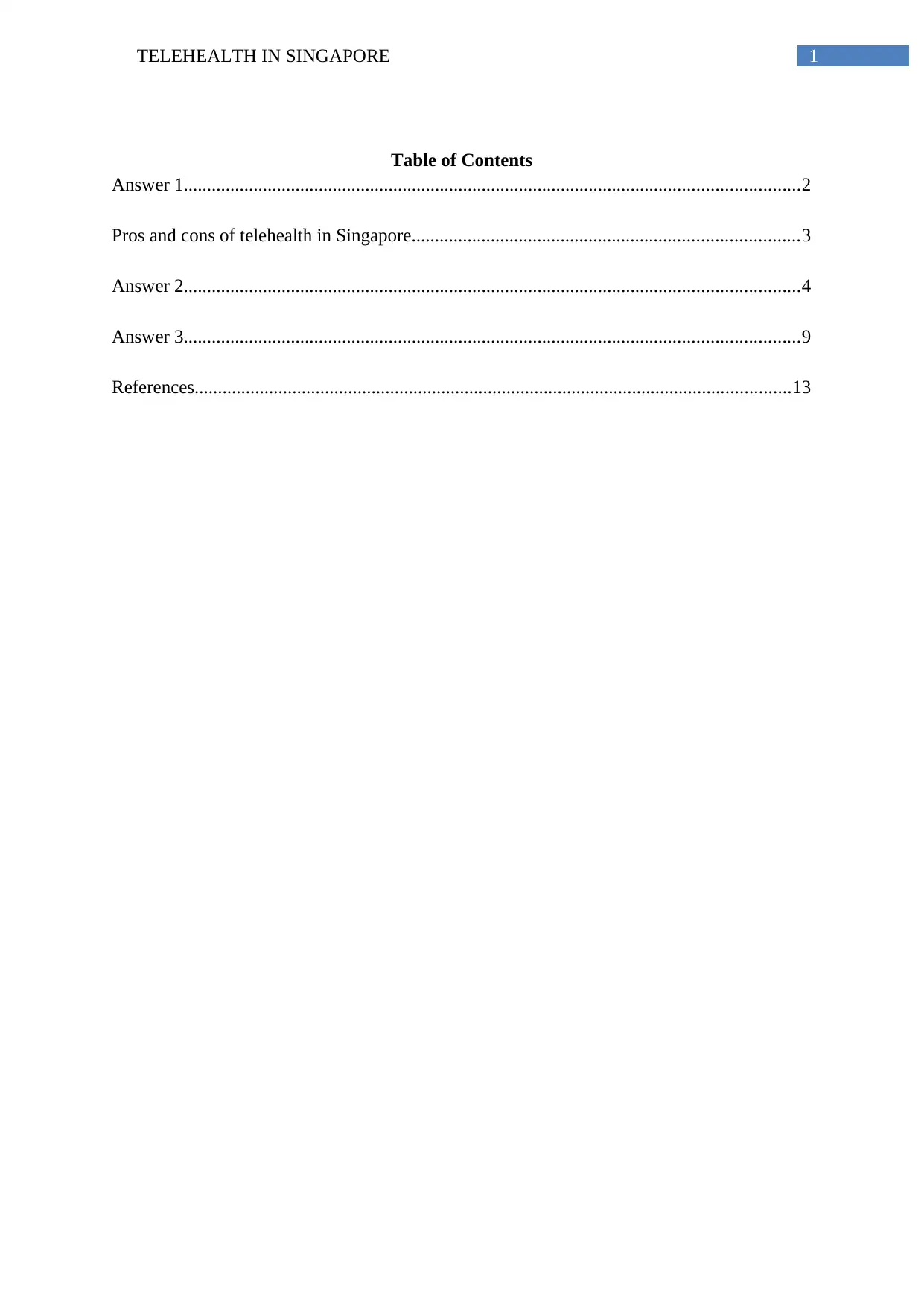
1TELEHEALTH IN SINGAPORE
Table of Contents
Answer 1....................................................................................................................................2
Pros and cons of telehealth in Singapore...................................................................................3
Answer 2....................................................................................................................................4
Answer 3....................................................................................................................................9
References................................................................................................................................13
Table of Contents
Answer 1....................................................................................................................................2
Pros and cons of telehealth in Singapore...................................................................................3
Answer 2....................................................................................................................................4
Answer 3....................................................................................................................................9
References................................................................................................................................13
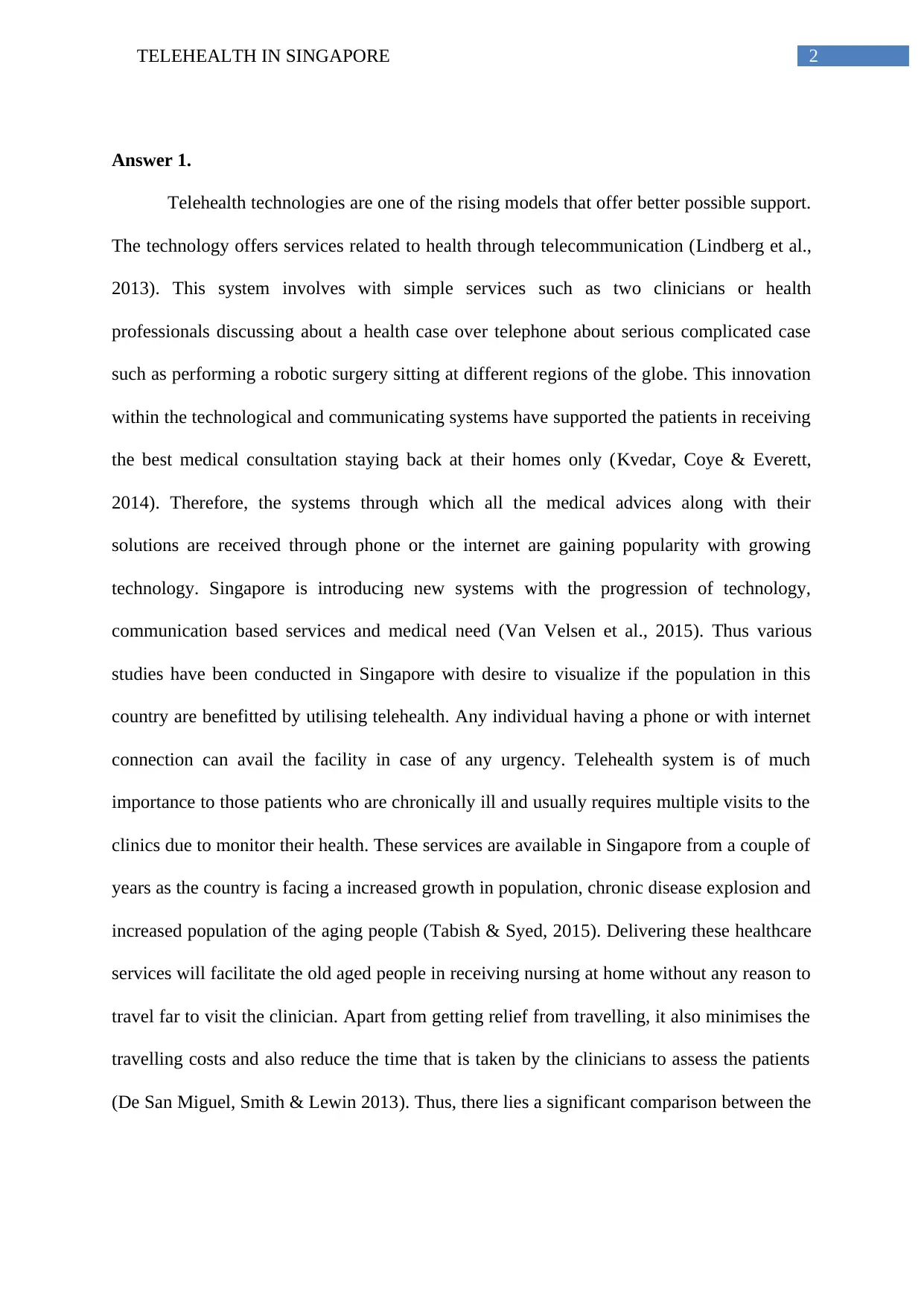
2TELEHEALTH IN SINGAPORE
Answer 1.
Telehealth technologies are one of the rising models that offer better possible support.
The technology offers services related to health through telecommunication (Lindberg et al.,
2013). This system involves with simple services such as two clinicians or health
professionals discussing about a health case over telephone about serious complicated case
such as performing a robotic surgery sitting at different regions of the globe. This innovation
within the technological and communicating systems have supported the patients in receiving
the best medical consultation staying back at their homes only (Kvedar, Coye & Everett,
2014). Therefore, the systems through which all the medical advices along with their
solutions are received through phone or the internet are gaining popularity with growing
technology. Singapore is introducing new systems with the progression of technology,
communication based services and medical need (Van Velsen et al., 2015). Thus various
studies have been conducted in Singapore with desire to visualize if the population in this
country are benefitted by utilising telehealth. Any individual having a phone or with internet
connection can avail the facility in case of any urgency. Telehealth system is of much
importance to those patients who are chronically ill and usually requires multiple visits to the
clinics due to monitor their health. These services are available in Singapore from a couple of
years as the country is facing a increased growth in population, chronic disease explosion and
increased population of the aging people (Tabish & Syed, 2015). Delivering these healthcare
services will facilitate the old aged people in receiving nursing at home without any reason to
travel far to visit the clinician. Apart from getting relief from travelling, it also minimises the
travelling costs and also reduce the time that is taken by the clinicians to assess the patients
(De San Miguel, Smith & Lewin 2013). Thus, there lies a significant comparison between the
Answer 1.
Telehealth technologies are one of the rising models that offer better possible support.
The technology offers services related to health through telecommunication (Lindberg et al.,
2013). This system involves with simple services such as two clinicians or health
professionals discussing about a health case over telephone about serious complicated case
such as performing a robotic surgery sitting at different regions of the globe. This innovation
within the technological and communicating systems have supported the patients in receiving
the best medical consultation staying back at their homes only (Kvedar, Coye & Everett,
2014). Therefore, the systems through which all the medical advices along with their
solutions are received through phone or the internet are gaining popularity with growing
technology. Singapore is introducing new systems with the progression of technology,
communication based services and medical need (Van Velsen et al., 2015). Thus various
studies have been conducted in Singapore with desire to visualize if the population in this
country are benefitted by utilising telehealth. Any individual having a phone or with internet
connection can avail the facility in case of any urgency. Telehealth system is of much
importance to those patients who are chronically ill and usually requires multiple visits to the
clinics due to monitor their health. These services are available in Singapore from a couple of
years as the country is facing a increased growth in population, chronic disease explosion and
increased population of the aging people (Tabish & Syed, 2015). Delivering these healthcare
services will facilitate the old aged people in receiving nursing at home without any reason to
travel far to visit the clinician. Apart from getting relief from travelling, it also minimises the
travelling costs and also reduce the time that is taken by the clinicians to assess the patients
(De San Miguel, Smith & Lewin 2013). Thus, there lies a significant comparison between the
⊘ This is a preview!⊘
Do you want full access?
Subscribe today to unlock all pages.

Trusted by 1+ million students worldwide
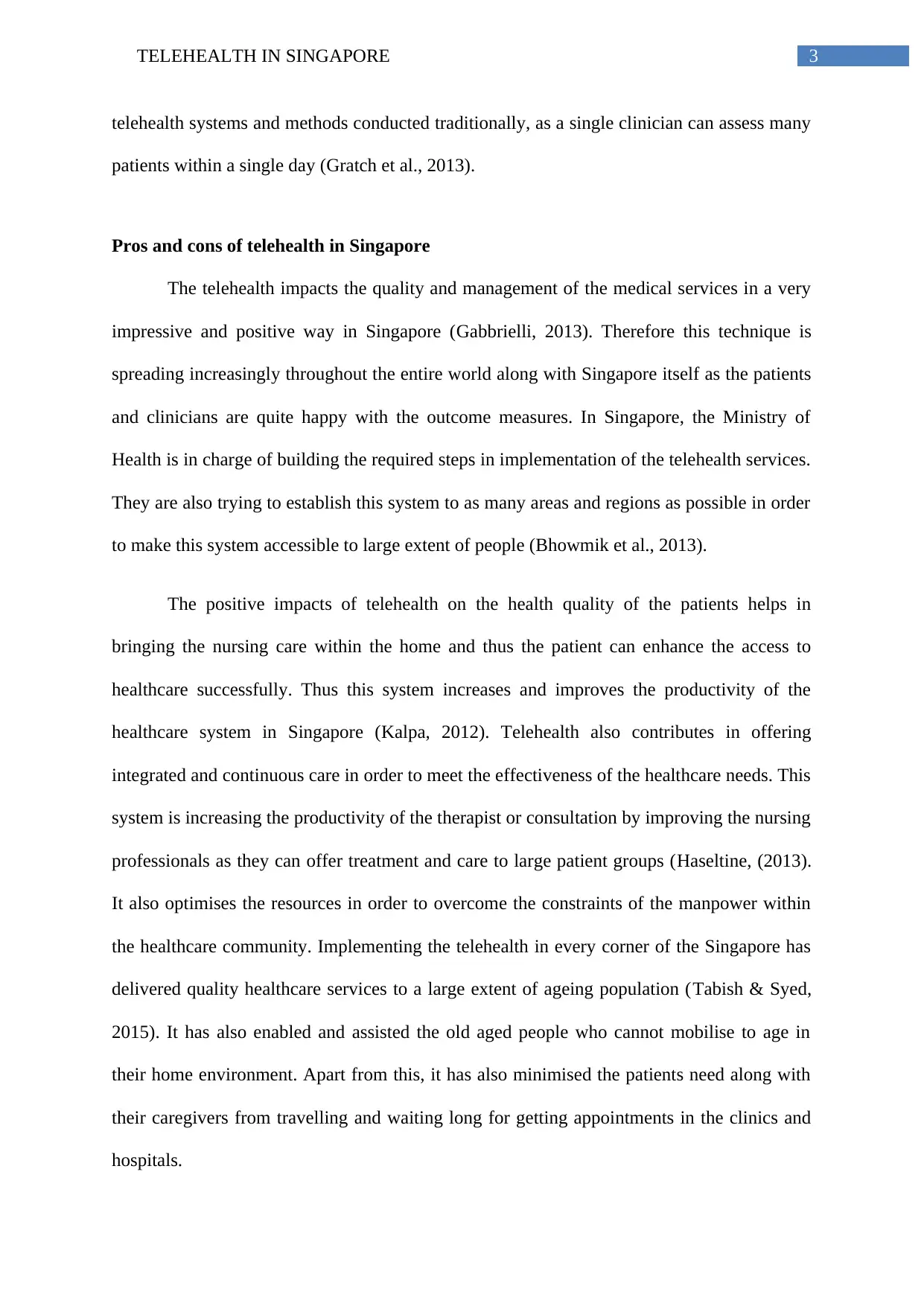
3TELEHEALTH IN SINGAPORE
telehealth systems and methods conducted traditionally, as a single clinician can assess many
patients within a single day (Gratch et al., 2013).
Pros and cons of telehealth in Singapore
The telehealth impacts the quality and management of the medical services in a very
impressive and positive way in Singapore (Gabbrielli, 2013). Therefore this technique is
spreading increasingly throughout the entire world along with Singapore itself as the patients
and clinicians are quite happy with the outcome measures. In Singapore, the Ministry of
Health is in charge of building the required steps in implementation of the telehealth services.
They are also trying to establish this system to as many areas and regions as possible in order
to make this system accessible to large extent of people (Bhowmik et al., 2013).
The positive impacts of telehealth on the health quality of the patients helps in
bringing the nursing care within the home and thus the patient can enhance the access to
healthcare successfully. Thus this system increases and improves the productivity of the
healthcare system in Singapore (Kalpa, 2012). Telehealth also contributes in offering
integrated and continuous care in order to meet the effectiveness of the healthcare needs. This
system is increasing the productivity of the therapist or consultation by improving the nursing
professionals as they can offer treatment and care to large patient groups (Haseltine, (2013).
It also optimises the resources in order to overcome the constraints of the manpower within
the healthcare community. Implementing the telehealth in every corner of the Singapore has
delivered quality healthcare services to a large extent of ageing population (Tabish & Syed,
2015). It has also enabled and assisted the old aged people who cannot mobilise to age in
their home environment. Apart from this, it has also minimised the patients need along with
their caregivers from travelling and waiting long for getting appointments in the clinics and
hospitals.
telehealth systems and methods conducted traditionally, as a single clinician can assess many
patients within a single day (Gratch et al., 2013).
Pros and cons of telehealth in Singapore
The telehealth impacts the quality and management of the medical services in a very
impressive and positive way in Singapore (Gabbrielli, 2013). Therefore this technique is
spreading increasingly throughout the entire world along with Singapore itself as the patients
and clinicians are quite happy with the outcome measures. In Singapore, the Ministry of
Health is in charge of building the required steps in implementation of the telehealth services.
They are also trying to establish this system to as many areas and regions as possible in order
to make this system accessible to large extent of people (Bhowmik et al., 2013).
The positive impacts of telehealth on the health quality of the patients helps in
bringing the nursing care within the home and thus the patient can enhance the access to
healthcare successfully. Thus this system increases and improves the productivity of the
healthcare system in Singapore (Kalpa, 2012). Telehealth also contributes in offering
integrated and continuous care in order to meet the effectiveness of the healthcare needs. This
system is increasing the productivity of the therapist or consultation by improving the nursing
professionals as they can offer treatment and care to large patient groups (Haseltine, (2013).
It also optimises the resources in order to overcome the constraints of the manpower within
the healthcare community. Implementing the telehealth in every corner of the Singapore has
delivered quality healthcare services to a large extent of ageing population (Tabish & Syed,
2015). It has also enabled and assisted the old aged people who cannot mobilise to age in
their home environment. Apart from this, it has also minimised the patients need along with
their caregivers from travelling and waiting long for getting appointments in the clinics and
hospitals.
Paraphrase This Document
Need a fresh take? Get an instant paraphrase of this document with our AI Paraphraser
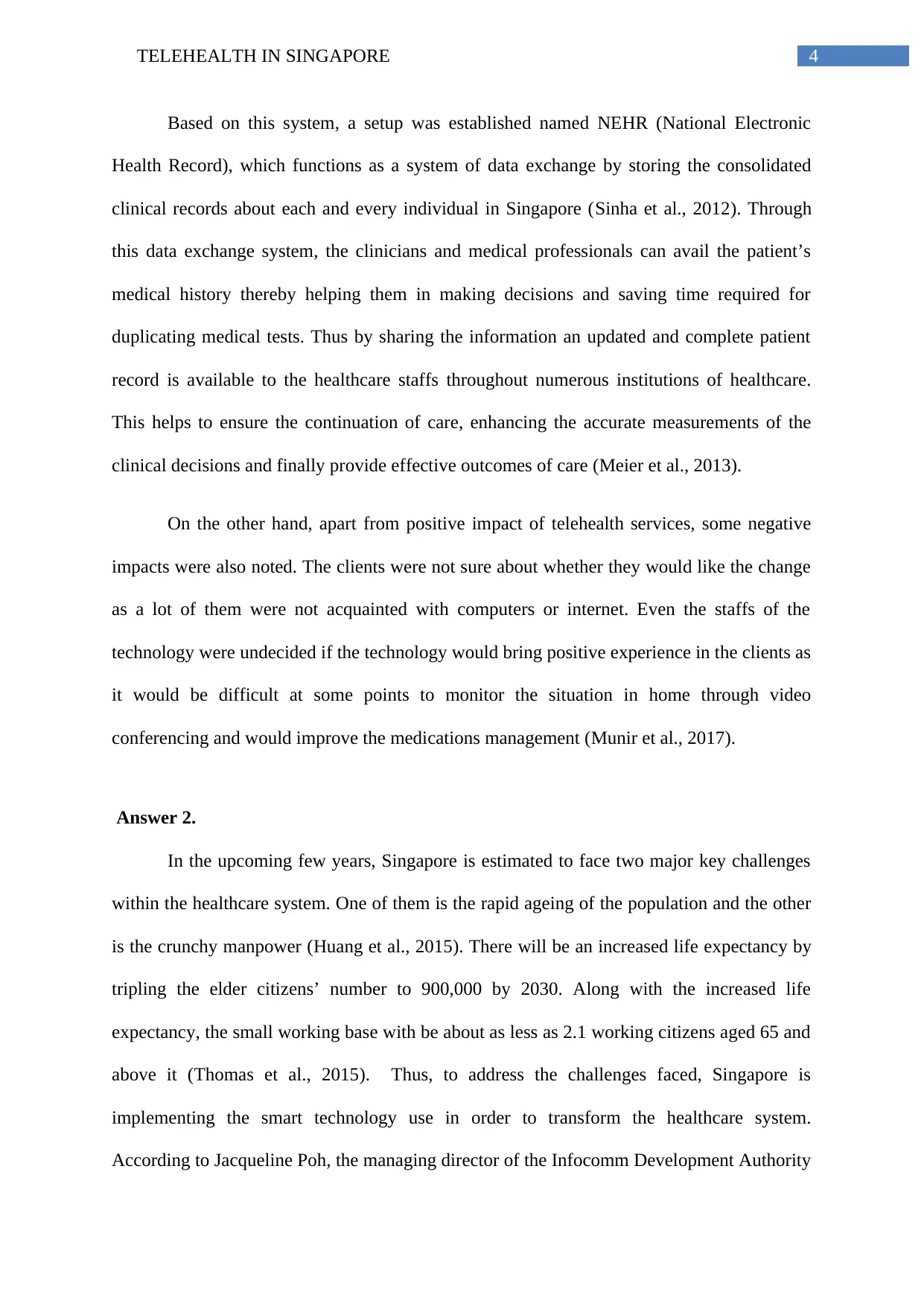
4TELEHEALTH IN SINGAPORE
Based on this system, a setup was established named NEHR (National Electronic
Health Record), which functions as a system of data exchange by storing the consolidated
clinical records about each and every individual in Singapore (Sinha et al., 2012). Through
this data exchange system, the clinicians and medical professionals can avail the patient’s
medical history thereby helping them in making decisions and saving time required for
duplicating medical tests. Thus by sharing the information an updated and complete patient
record is available to the healthcare staffs throughout numerous institutions of healthcare.
This helps to ensure the continuation of care, enhancing the accurate measurements of the
clinical decisions and finally provide effective outcomes of care (Meier et al., 2013).
On the other hand, apart from positive impact of telehealth services, some negative
impacts were also noted. The clients were not sure about whether they would like the change
as a lot of them were not acquainted with computers or internet. Even the staffs of the
technology were undecided if the technology would bring positive experience in the clients as
it would be difficult at some points to monitor the situation in home through video
conferencing and would improve the medications management (Munir et al., 2017).
Answer 2.
In the upcoming few years, Singapore is estimated to face two major key challenges
within the healthcare system. One of them is the rapid ageing of the population and the other
is the crunchy manpower (Huang et al., 2015). There will be an increased life expectancy by
tripling the elder citizens’ number to 900,000 by 2030. Along with the increased life
expectancy, the small working base with be about as less as 2.1 working citizens aged 65 and
above it (Thomas et al., 2015). Thus, to address the challenges faced, Singapore is
implementing the smart technology use in order to transform the healthcare system.
According to Jacqueline Poh, the managing director of the Infocomm Development Authority
Based on this system, a setup was established named NEHR (National Electronic
Health Record), which functions as a system of data exchange by storing the consolidated
clinical records about each and every individual in Singapore (Sinha et al., 2012). Through
this data exchange system, the clinicians and medical professionals can avail the patient’s
medical history thereby helping them in making decisions and saving time required for
duplicating medical tests. Thus by sharing the information an updated and complete patient
record is available to the healthcare staffs throughout numerous institutions of healthcare.
This helps to ensure the continuation of care, enhancing the accurate measurements of the
clinical decisions and finally provide effective outcomes of care (Meier et al., 2013).
On the other hand, apart from positive impact of telehealth services, some negative
impacts were also noted. The clients were not sure about whether they would like the change
as a lot of them were not acquainted with computers or internet. Even the staffs of the
technology were undecided if the technology would bring positive experience in the clients as
it would be difficult at some points to monitor the situation in home through video
conferencing and would improve the medications management (Munir et al., 2017).
Answer 2.
In the upcoming few years, Singapore is estimated to face two major key challenges
within the healthcare system. One of them is the rapid ageing of the population and the other
is the crunchy manpower (Huang et al., 2015). There will be an increased life expectancy by
tripling the elder citizens’ number to 900,000 by 2030. Along with the increased life
expectancy, the small working base with be about as less as 2.1 working citizens aged 65 and
above it (Thomas et al., 2015). Thus, to address the challenges faced, Singapore is
implementing the smart technology use in order to transform the healthcare system.
According to Jacqueline Poh, the managing director of the Infocomm Development Authority
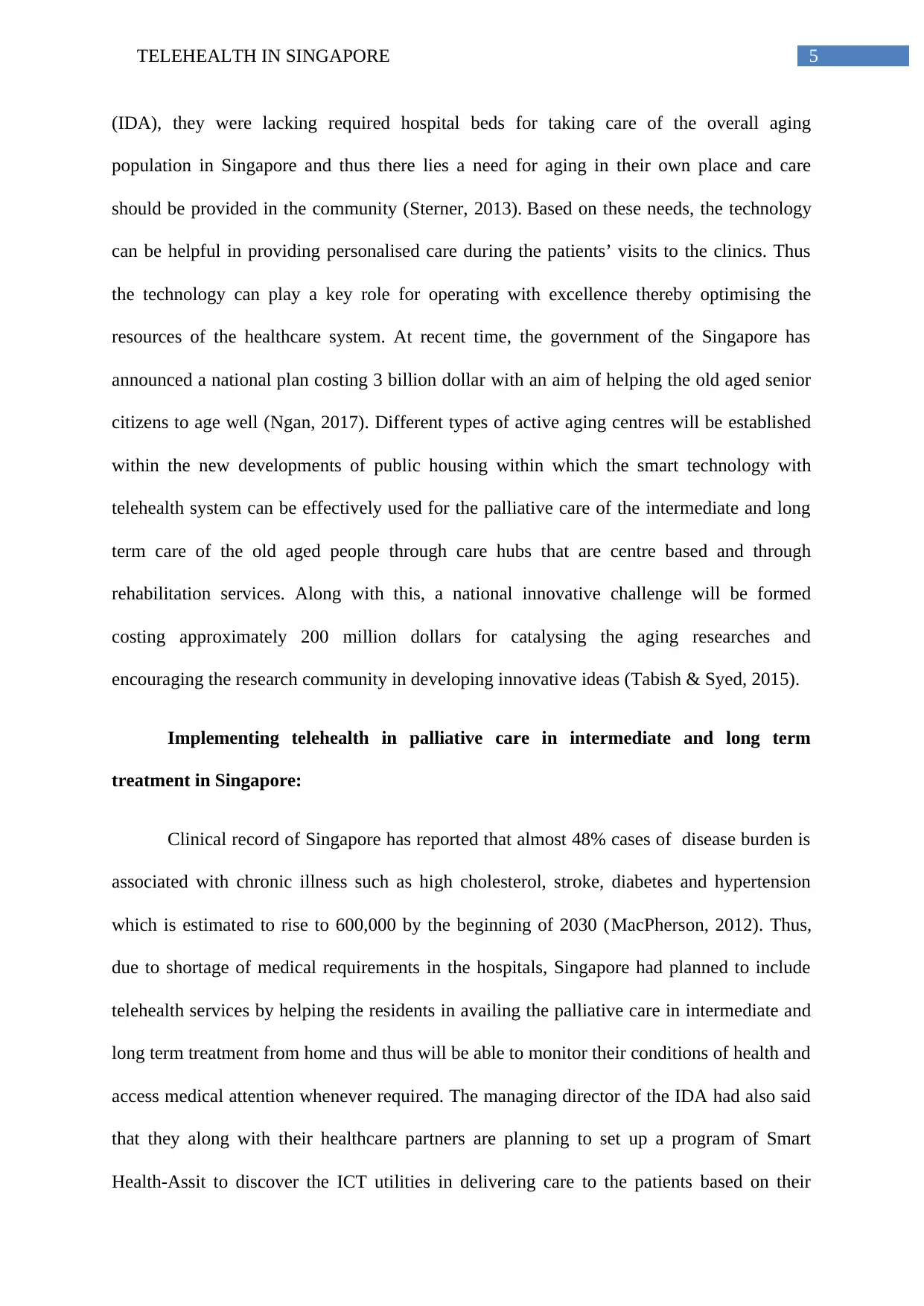
5TELEHEALTH IN SINGAPORE
(IDA), they were lacking required hospital beds for taking care of the overall aging
population in Singapore and thus there lies a need for aging in their own place and care
should be provided in the community (Sterner, 2013). Based on these needs, the technology
can be helpful in providing personalised care during the patients’ visits to the clinics. Thus
the technology can play a key role for operating with excellence thereby optimising the
resources of the healthcare system. At recent time, the government of the Singapore has
announced a national plan costing 3 billion dollar with an aim of helping the old aged senior
citizens to age well (Ngan, 2017). Different types of active aging centres will be established
within the new developments of public housing within which the smart technology with
telehealth system can be effectively used for the palliative care of the intermediate and long
term care of the old aged people through care hubs that are centre based and through
rehabilitation services. Along with this, a national innovative challenge will be formed
costing approximately 200 million dollars for catalysing the aging researches and
encouraging the research community in developing innovative ideas (Tabish & Syed, 2015).
Implementing telehealth in palliative care in intermediate and long term
treatment in Singapore:
Clinical record of Singapore has reported that almost 48% cases of disease burden is
associated with chronic illness such as high cholesterol, stroke, diabetes and hypertension
which is estimated to rise to 600,000 by the beginning of 2030 (MacPherson, 2012). Thus,
due to shortage of medical requirements in the hospitals, Singapore had planned to include
telehealth services by helping the residents in availing the palliative care in intermediate and
long term treatment from home and thus will be able to monitor their conditions of health and
access medical attention whenever required. The managing director of the IDA had also said
that they along with their healthcare partners are planning to set up a program of Smart
Health-Assit to discover the ICT utilities in delivering care to the patients based on their
(IDA), they were lacking required hospital beds for taking care of the overall aging
population in Singapore and thus there lies a need for aging in their own place and care
should be provided in the community (Sterner, 2013). Based on these needs, the technology
can be helpful in providing personalised care during the patients’ visits to the clinics. Thus
the technology can play a key role for operating with excellence thereby optimising the
resources of the healthcare system. At recent time, the government of the Singapore has
announced a national plan costing 3 billion dollar with an aim of helping the old aged senior
citizens to age well (Ngan, 2017). Different types of active aging centres will be established
within the new developments of public housing within which the smart technology with
telehealth system can be effectively used for the palliative care of the intermediate and long
term care of the old aged people through care hubs that are centre based and through
rehabilitation services. Along with this, a national innovative challenge will be formed
costing approximately 200 million dollars for catalysing the aging researches and
encouraging the research community in developing innovative ideas (Tabish & Syed, 2015).
Implementing telehealth in palliative care in intermediate and long term
treatment in Singapore:
Clinical record of Singapore has reported that almost 48% cases of disease burden is
associated with chronic illness such as high cholesterol, stroke, diabetes and hypertension
which is estimated to rise to 600,000 by the beginning of 2030 (MacPherson, 2012). Thus,
due to shortage of medical requirements in the hospitals, Singapore had planned to include
telehealth services by helping the residents in availing the palliative care in intermediate and
long term treatment from home and thus will be able to monitor their conditions of health and
access medical attention whenever required. The managing director of the IDA had also said
that they along with their healthcare partners are planning to set up a program of Smart
Health-Assit to discover the ICT utilities in delivering care to the patients based on their
⊘ This is a preview!⊘
Do you want full access?
Subscribe today to unlock all pages.

Trusted by 1+ million students worldwide
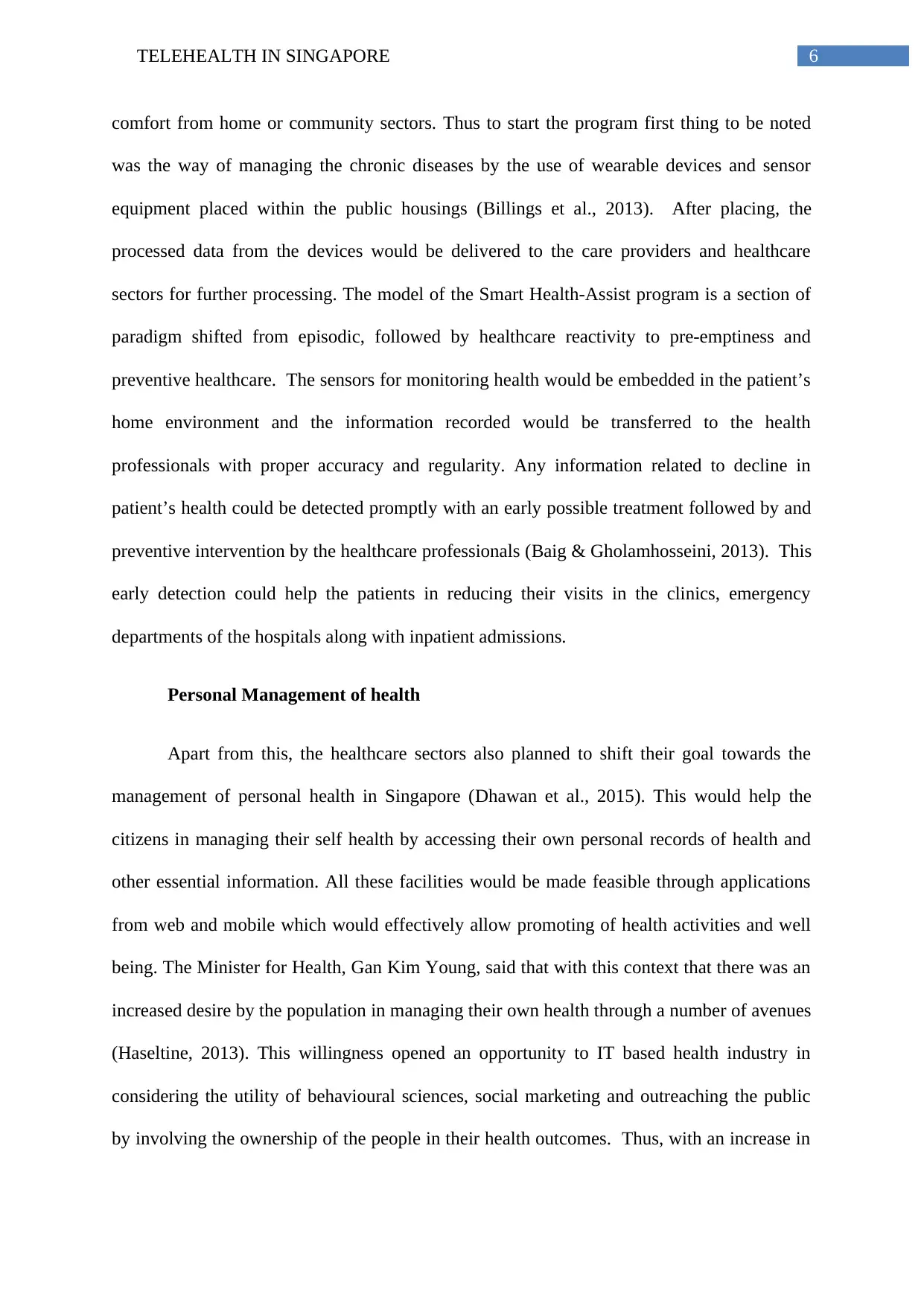
6TELEHEALTH IN SINGAPORE
comfort from home or community sectors. Thus to start the program first thing to be noted
was the way of managing the chronic diseases by the use of wearable devices and sensor
equipment placed within the public housings (Billings et al., 2013). After placing, the
processed data from the devices would be delivered to the care providers and healthcare
sectors for further processing. The model of the Smart Health-Assist program is a section of
paradigm shifted from episodic, followed by healthcare reactivity to pre-emptiness and
preventive healthcare. The sensors for monitoring health would be embedded in the patient’s
home environment and the information recorded would be transferred to the health
professionals with proper accuracy and regularity. Any information related to decline in
patient’s health could be detected promptly with an early possible treatment followed by and
preventive intervention by the healthcare professionals (Baig & Gholamhosseini, 2013). This
early detection could help the patients in reducing their visits in the clinics, emergency
departments of the hospitals along with inpatient admissions.
Personal Management of health
Apart from this, the healthcare sectors also planned to shift their goal towards the
management of personal health in Singapore (Dhawan et al., 2015). This would help the
citizens in managing their self health by accessing their own personal records of health and
other essential information. All these facilities would be made feasible through applications
from web and mobile which would effectively allow promoting of health activities and well
being. The Minister for Health, Gan Kim Young, said that with this context that there was an
increased desire by the population in managing their own health through a number of avenues
(Haseltine, 2013). This willingness opened an opportunity to IT based health industry in
considering the utility of behavioural sciences, social marketing and outreaching the public
by involving the ownership of the people in their health outcomes. Thus, with an increase in
comfort from home or community sectors. Thus to start the program first thing to be noted
was the way of managing the chronic diseases by the use of wearable devices and sensor
equipment placed within the public housings (Billings et al., 2013). After placing, the
processed data from the devices would be delivered to the care providers and healthcare
sectors for further processing. The model of the Smart Health-Assist program is a section of
paradigm shifted from episodic, followed by healthcare reactivity to pre-emptiness and
preventive healthcare. The sensors for monitoring health would be embedded in the patient’s
home environment and the information recorded would be transferred to the health
professionals with proper accuracy and regularity. Any information related to decline in
patient’s health could be detected promptly with an early possible treatment followed by and
preventive intervention by the healthcare professionals (Baig & Gholamhosseini, 2013). This
early detection could help the patients in reducing their visits in the clinics, emergency
departments of the hospitals along with inpatient admissions.
Personal Management of health
Apart from this, the healthcare sectors also planned to shift their goal towards the
management of personal health in Singapore (Dhawan et al., 2015). This would help the
citizens in managing their self health by accessing their own personal records of health and
other essential information. All these facilities would be made feasible through applications
from web and mobile which would effectively allow promoting of health activities and well
being. The Minister for Health, Gan Kim Young, said that with this context that there was an
increased desire by the population in managing their own health through a number of avenues
(Haseltine, 2013). This willingness opened an opportunity to IT based health industry in
considering the utility of behavioural sciences, social marketing and outreaching the public
by involving the ownership of the people in their health outcomes. Thus, with an increase in
Paraphrase This Document
Need a fresh take? Get an instant paraphrase of this document with our AI Paraphraser
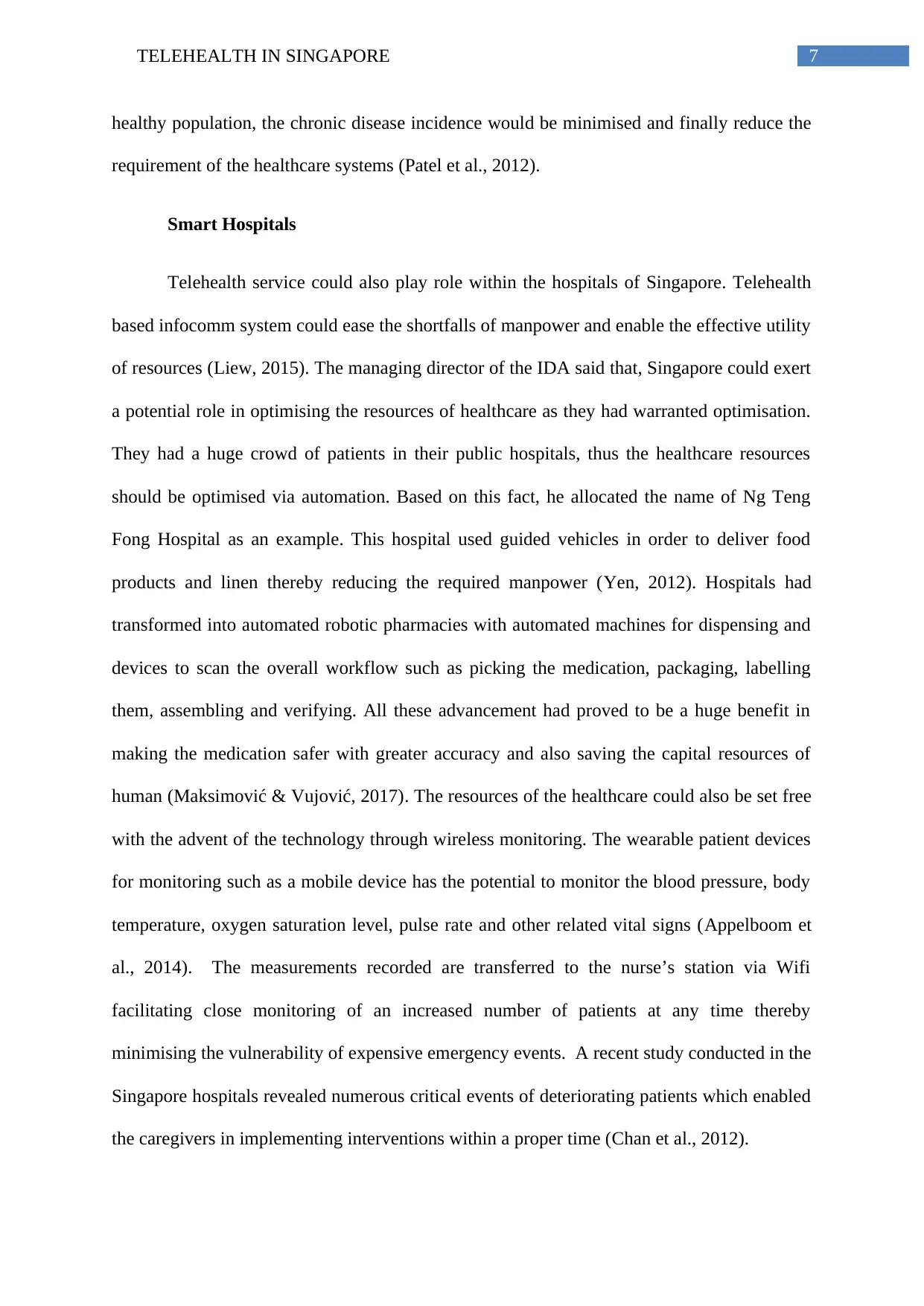
7TELEHEALTH IN SINGAPORE
healthy population, the chronic disease incidence would be minimised and finally reduce the
requirement of the healthcare systems (Patel et al., 2012).
Smart Hospitals
Telehealth service could also play role within the hospitals of Singapore. Telehealth
based infocomm system could ease the shortfalls of manpower and enable the effective utility
of resources (Liew, 2015). The managing director of the IDA said that, Singapore could exert
a potential role in optimising the resources of healthcare as they had warranted optimisation.
They had a huge crowd of patients in their public hospitals, thus the healthcare resources
should be optimised via automation. Based on this fact, he allocated the name of Ng Teng
Fong Hospital as an example. This hospital used guided vehicles in order to deliver food
products and linen thereby reducing the required manpower (Yen, 2012). Hospitals had
transformed into automated robotic pharmacies with automated machines for dispensing and
devices to scan the overall workflow such as picking the medication, packaging, labelling
them, assembling and verifying. All these advancement had proved to be a huge benefit in
making the medication safer with greater accuracy and also saving the capital resources of
human (Maksimović & Vujović, 2017). The resources of the healthcare could also be set free
with the advent of the technology through wireless monitoring. The wearable patient devices
for monitoring such as a mobile device has the potential to monitor the blood pressure, body
temperature, oxygen saturation level, pulse rate and other related vital signs (Appelboom et
al., 2014). The measurements recorded are transferred to the nurse’s station via Wifi
facilitating close monitoring of an increased number of patients at any time thereby
minimising the vulnerability of expensive emergency events. A recent study conducted in the
Singapore hospitals revealed numerous critical events of deteriorating patients which enabled
the caregivers in implementing interventions within a proper time (Chan et al., 2012).
healthy population, the chronic disease incidence would be minimised and finally reduce the
requirement of the healthcare systems (Patel et al., 2012).
Smart Hospitals
Telehealth service could also play role within the hospitals of Singapore. Telehealth
based infocomm system could ease the shortfalls of manpower and enable the effective utility
of resources (Liew, 2015). The managing director of the IDA said that, Singapore could exert
a potential role in optimising the resources of healthcare as they had warranted optimisation.
They had a huge crowd of patients in their public hospitals, thus the healthcare resources
should be optimised via automation. Based on this fact, he allocated the name of Ng Teng
Fong Hospital as an example. This hospital used guided vehicles in order to deliver food
products and linen thereby reducing the required manpower (Yen, 2012). Hospitals had
transformed into automated robotic pharmacies with automated machines for dispensing and
devices to scan the overall workflow such as picking the medication, packaging, labelling
them, assembling and verifying. All these advancement had proved to be a huge benefit in
making the medication safer with greater accuracy and also saving the capital resources of
human (Maksimović & Vujović, 2017). The resources of the healthcare could also be set free
with the advent of the technology through wireless monitoring. The wearable patient devices
for monitoring such as a mobile device has the potential to monitor the blood pressure, body
temperature, oxygen saturation level, pulse rate and other related vital signs (Appelboom et
al., 2014). The measurements recorded are transferred to the nurse’s station via Wifi
facilitating close monitoring of an increased number of patients at any time thereby
minimising the vulnerability of expensive emergency events. A recent study conducted in the
Singapore hospitals revealed numerous critical events of deteriorating patients which enabled
the caregivers in implementing interventions within a proper time (Chan et al., 2012).
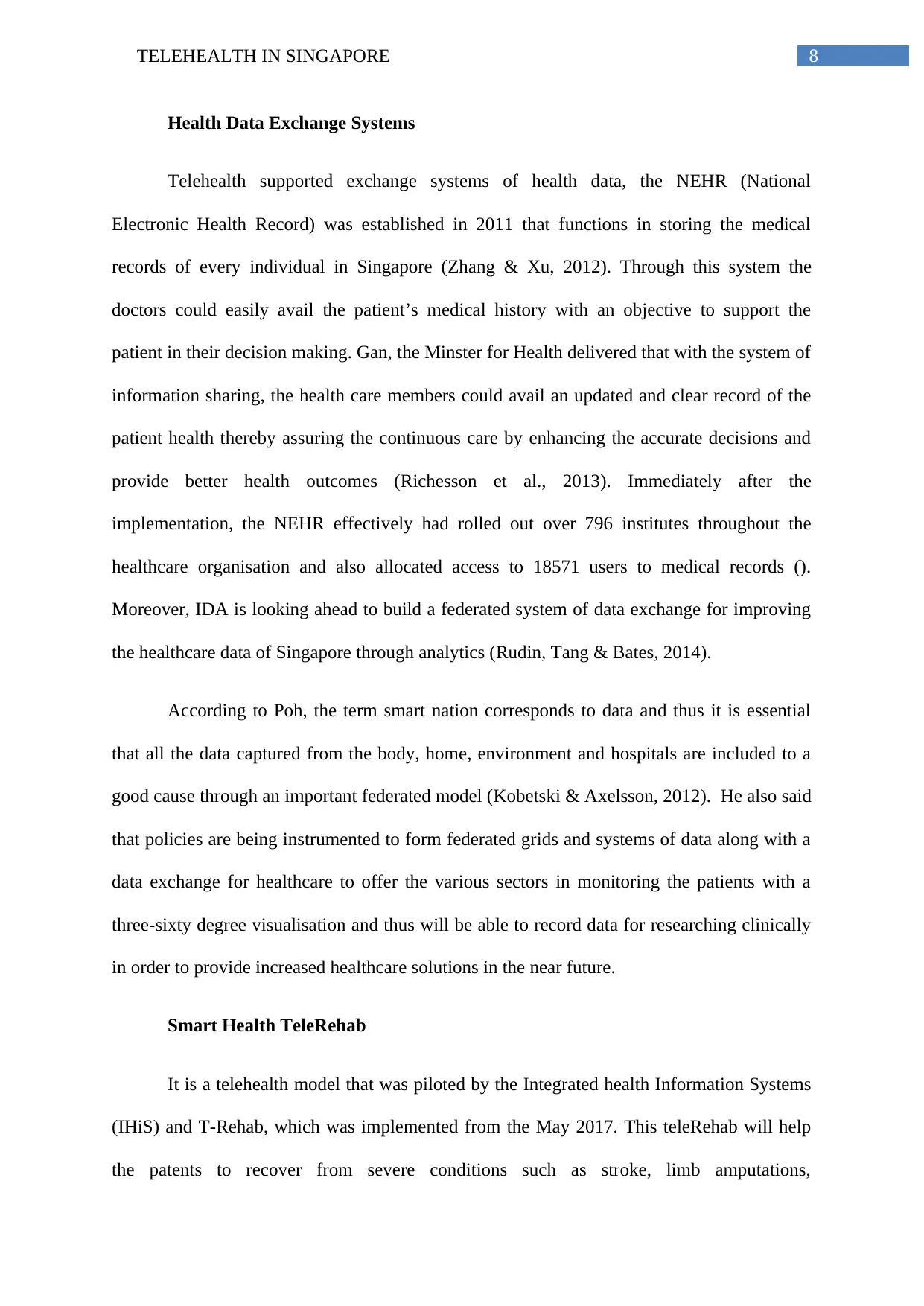
8TELEHEALTH IN SINGAPORE
Health Data Exchange Systems
Telehealth supported exchange systems of health data, the NEHR (National
Electronic Health Record) was established in 2011 that functions in storing the medical
records of every individual in Singapore (Zhang & Xu, 2012). Through this system the
doctors could easily avail the patient’s medical history with an objective to support the
patient in their decision making. Gan, the Minster for Health delivered that with the system of
information sharing, the health care members could avail an updated and clear record of the
patient health thereby assuring the continuous care by enhancing the accurate decisions and
provide better health outcomes (Richesson et al., 2013). Immediately after the
implementation, the NEHR effectively had rolled out over 796 institutes throughout the
healthcare organisation and also allocated access to 18571 users to medical records ().
Moreover, IDA is looking ahead to build a federated system of data exchange for improving
the healthcare data of Singapore through analytics (Rudin, Tang & Bates, 2014).
According to Poh, the term smart nation corresponds to data and thus it is essential
that all the data captured from the body, home, environment and hospitals are included to a
good cause through an important federated model (Kobetski & Axelsson, 2012). He also said
that policies are being instrumented to form federated grids and systems of data along with a
data exchange for healthcare to offer the various sectors in monitoring the patients with a
three-sixty degree visualisation and thus will be able to record data for researching clinically
in order to provide increased healthcare solutions in the near future.
Smart Health TeleRehab
It is a telehealth model that was piloted by the Integrated health Information Systems
(IHiS) and T-Rehab, which was implemented from the May 2017. This teleRehab will help
the patents to recover from severe conditions such as stroke, limb amputations,
Health Data Exchange Systems
Telehealth supported exchange systems of health data, the NEHR (National
Electronic Health Record) was established in 2011 that functions in storing the medical
records of every individual in Singapore (Zhang & Xu, 2012). Through this system the
doctors could easily avail the patient’s medical history with an objective to support the
patient in their decision making. Gan, the Minster for Health delivered that with the system of
information sharing, the health care members could avail an updated and clear record of the
patient health thereby assuring the continuous care by enhancing the accurate decisions and
provide better health outcomes (Richesson et al., 2013). Immediately after the
implementation, the NEHR effectively had rolled out over 796 institutes throughout the
healthcare organisation and also allocated access to 18571 users to medical records ().
Moreover, IDA is looking ahead to build a federated system of data exchange for improving
the healthcare data of Singapore through analytics (Rudin, Tang & Bates, 2014).
According to Poh, the term smart nation corresponds to data and thus it is essential
that all the data captured from the body, home, environment and hospitals are included to a
good cause through an important federated model (Kobetski & Axelsson, 2012). He also said
that policies are being instrumented to form federated grids and systems of data along with a
data exchange for healthcare to offer the various sectors in monitoring the patients with a
three-sixty degree visualisation and thus will be able to record data for researching clinically
in order to provide increased healthcare solutions in the near future.
Smart Health TeleRehab
It is a telehealth model that was piloted by the Integrated health Information Systems
(IHiS) and T-Rehab, which was implemented from the May 2017. This teleRehab will help
the patents to recover from severe conditions such as stroke, limb amputations,
⊘ This is a preview!⊘
Do you want full access?
Subscribe today to unlock all pages.

Trusted by 1+ million students worldwide
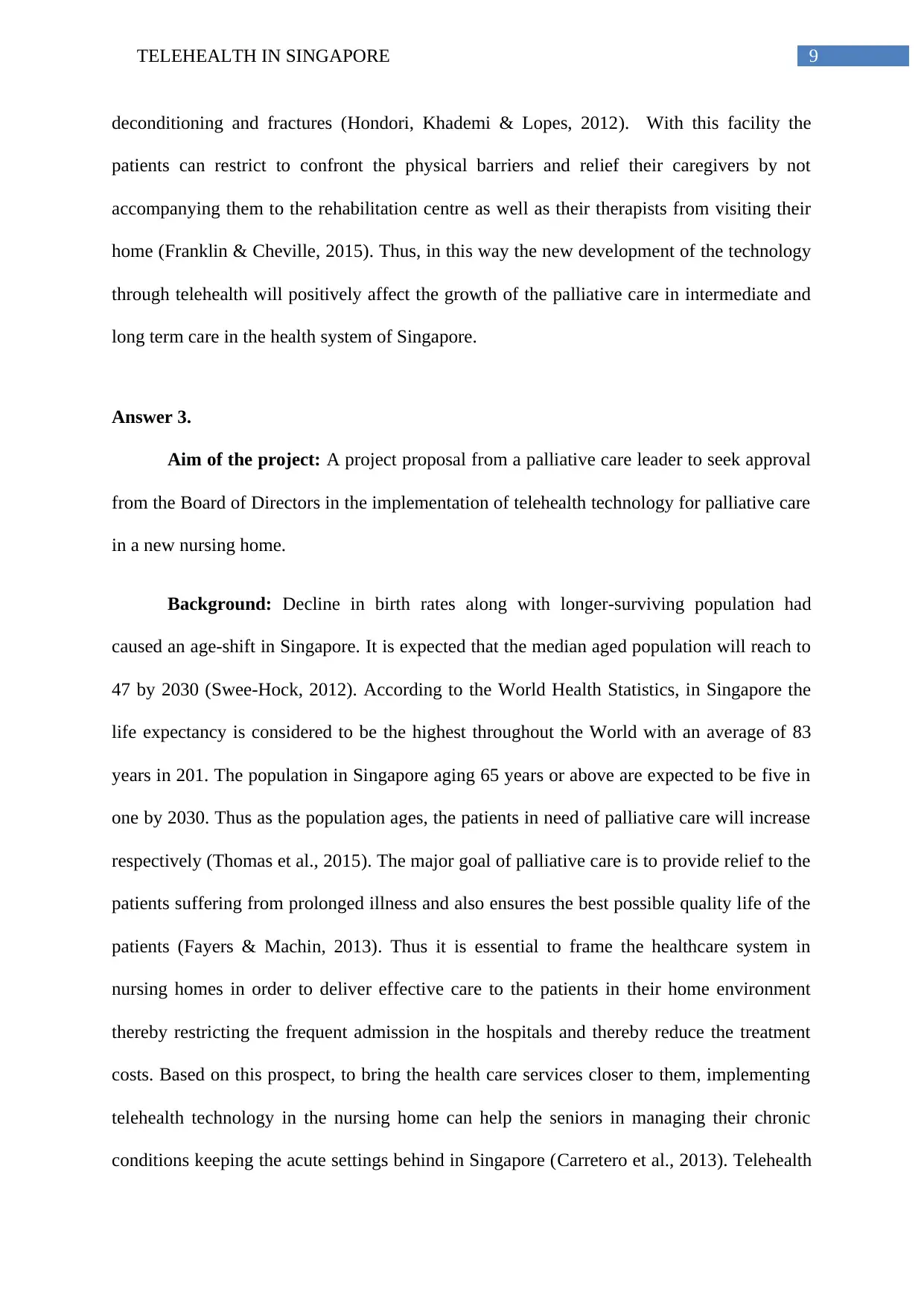
9TELEHEALTH IN SINGAPORE
deconditioning and fractures (Hondori, Khademi & Lopes, 2012). With this facility the
patients can restrict to confront the physical barriers and relief their caregivers by not
accompanying them to the rehabilitation centre as well as their therapists from visiting their
home (Franklin & Cheville, 2015). Thus, in this way the new development of the technology
through telehealth will positively affect the growth of the palliative care in intermediate and
long term care in the health system of Singapore.
Answer 3.
Aim of the project: A project proposal from a palliative care leader to seek approval
from the Board of Directors in the implementation of telehealth technology for palliative care
in a new nursing home.
Background: Decline in birth rates along with longer-surviving population had
caused an age-shift in Singapore. It is expected that the median aged population will reach to
47 by 2030 (Swee-Hock, 2012). According to the World Health Statistics, in Singapore the
life expectancy is considered to be the highest throughout the World with an average of 83
years in 201. The population in Singapore aging 65 years or above are expected to be five in
one by 2030. Thus as the population ages, the patients in need of palliative care will increase
respectively (Thomas et al., 2015). The major goal of palliative care is to provide relief to the
patients suffering from prolonged illness and also ensures the best possible quality life of the
patients (Fayers & Machin, 2013). Thus it is essential to frame the healthcare system in
nursing homes in order to deliver effective care to the patients in their home environment
thereby restricting the frequent admission in the hospitals and thereby reduce the treatment
costs. Based on this prospect, to bring the health care services closer to them, implementing
telehealth technology in the nursing home can help the seniors in managing their chronic
conditions keeping the acute settings behind in Singapore (Carretero et al., 2013). Telehealth
deconditioning and fractures (Hondori, Khademi & Lopes, 2012). With this facility the
patients can restrict to confront the physical barriers and relief their caregivers by not
accompanying them to the rehabilitation centre as well as their therapists from visiting their
home (Franklin & Cheville, 2015). Thus, in this way the new development of the technology
through telehealth will positively affect the growth of the palliative care in intermediate and
long term care in the health system of Singapore.
Answer 3.
Aim of the project: A project proposal from a palliative care leader to seek approval
from the Board of Directors in the implementation of telehealth technology for palliative care
in a new nursing home.
Background: Decline in birth rates along with longer-surviving population had
caused an age-shift in Singapore. It is expected that the median aged population will reach to
47 by 2030 (Swee-Hock, 2012). According to the World Health Statistics, in Singapore the
life expectancy is considered to be the highest throughout the World with an average of 83
years in 201. The population in Singapore aging 65 years or above are expected to be five in
one by 2030. Thus as the population ages, the patients in need of palliative care will increase
respectively (Thomas et al., 2015). The major goal of palliative care is to provide relief to the
patients suffering from prolonged illness and also ensures the best possible quality life of the
patients (Fayers & Machin, 2013). Thus it is essential to frame the healthcare system in
nursing homes in order to deliver effective care to the patients in their home environment
thereby restricting the frequent admission in the hospitals and thereby reduce the treatment
costs. Based on this prospect, to bring the health care services closer to them, implementing
telehealth technology in the nursing home can help the seniors in managing their chronic
conditions keeping the acute settings behind in Singapore (Carretero et al., 2013). Telehealth
Paraphrase This Document
Need a fresh take? Get an instant paraphrase of this document with our AI Paraphraser
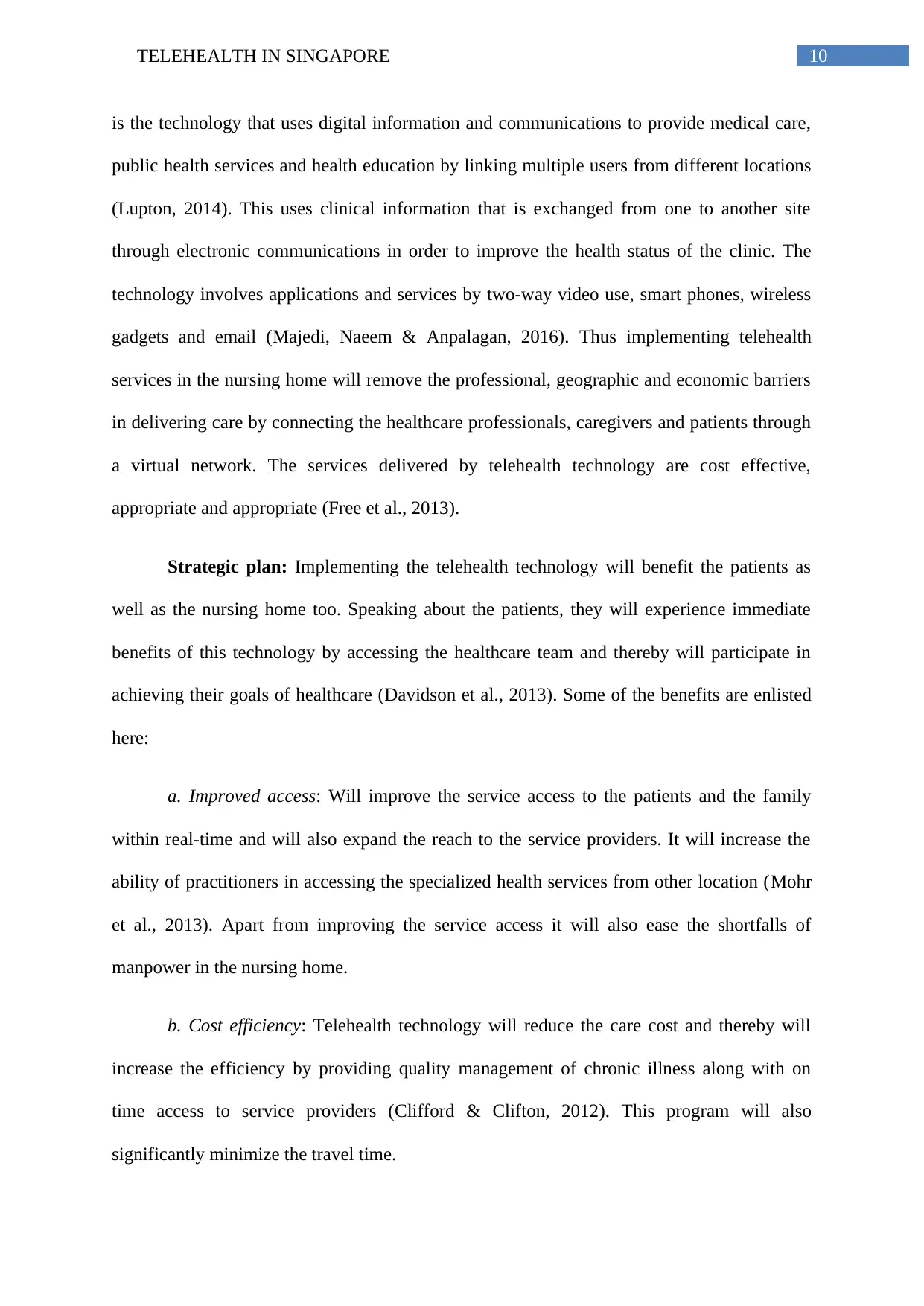
10TELEHEALTH IN SINGAPORE
is the technology that uses digital information and communications to provide medical care,
public health services and health education by linking multiple users from different locations
(Lupton, 2014). This uses clinical information that is exchanged from one to another site
through electronic communications in order to improve the health status of the clinic. The
technology involves applications and services by two-way video use, smart phones, wireless
gadgets and email (Majedi, Naeem & Anpalagan, 2016). Thus implementing telehealth
services in the nursing home will remove the professional, geographic and economic barriers
in delivering care by connecting the healthcare professionals, caregivers and patients through
a virtual network. The services delivered by telehealth technology are cost effective,
appropriate and appropriate (Free et al., 2013).
Strategic plan: Implementing the telehealth technology will benefit the patients as
well as the nursing home too. Speaking about the patients, they will experience immediate
benefits of this technology by accessing the healthcare team and thereby will participate in
achieving their goals of healthcare (Davidson et al., 2013). Some of the benefits are enlisted
here:
a. Improved access: Will improve the service access to the patients and the family
within real-time and will also expand the reach to the service providers. It will increase the
ability of practitioners in accessing the specialized health services from other location (Mohr
et al., 2013). Apart from improving the service access it will also ease the shortfalls of
manpower in the nursing home.
b. Cost efficiency: Telehealth technology will reduce the care cost and thereby will
increase the efficiency by providing quality management of chronic illness along with on
time access to service providers (Clifford & Clifton, 2012). This program will also
significantly minimize the travel time.
is the technology that uses digital information and communications to provide medical care,
public health services and health education by linking multiple users from different locations
(Lupton, 2014). This uses clinical information that is exchanged from one to another site
through electronic communications in order to improve the health status of the clinic. The
technology involves applications and services by two-way video use, smart phones, wireless
gadgets and email (Majedi, Naeem & Anpalagan, 2016). Thus implementing telehealth
services in the nursing home will remove the professional, geographic and economic barriers
in delivering care by connecting the healthcare professionals, caregivers and patients through
a virtual network. The services delivered by telehealth technology are cost effective,
appropriate and appropriate (Free et al., 2013).
Strategic plan: Implementing the telehealth technology will benefit the patients as
well as the nursing home too. Speaking about the patients, they will experience immediate
benefits of this technology by accessing the healthcare team and thereby will participate in
achieving their goals of healthcare (Davidson et al., 2013). Some of the benefits are enlisted
here:
a. Improved access: Will improve the service access to the patients and the family
within real-time and will also expand the reach to the service providers. It will increase the
ability of practitioners in accessing the specialized health services from other location (Mohr
et al., 2013). Apart from improving the service access it will also ease the shortfalls of
manpower in the nursing home.
b. Cost efficiency: Telehealth technology will reduce the care cost and thereby will
increase the efficiency by providing quality management of chronic illness along with on
time access to service providers (Clifford & Clifton, 2012). This program will also
significantly minimize the travel time.
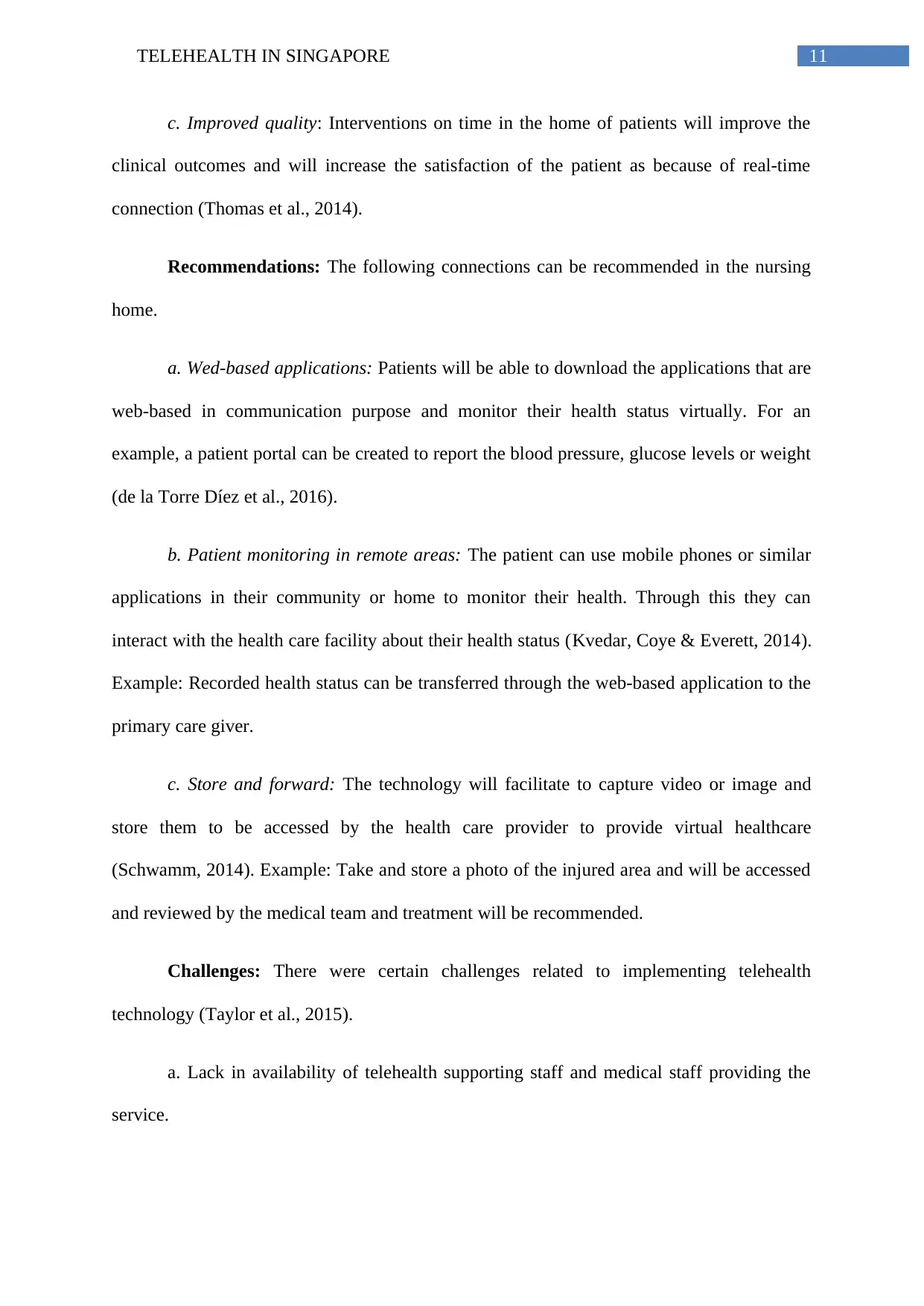
11TELEHEALTH IN SINGAPORE
c. Improved quality: Interventions on time in the home of patients will improve the
clinical outcomes and will increase the satisfaction of the patient as because of real-time
connection (Thomas et al., 2014).
Recommendations: The following connections can be recommended in the nursing
home.
a. Wed-based applications: Patients will be able to download the applications that are
web-based in communication purpose and monitor their health status virtually. For an
example, a patient portal can be created to report the blood pressure, glucose levels or weight
(de la Torre Díez et al., 2016).
b. Patient monitoring in remote areas: The patient can use mobile phones or similar
applications in their community or home to monitor their health. Through this they can
interact with the health care facility about their health status (Kvedar, Coye & Everett, 2014).
Example: Recorded health status can be transferred through the web-based application to the
primary care giver.
c. Store and forward: The technology will facilitate to capture video or image and
store them to be accessed by the health care provider to provide virtual healthcare
(Schwamm, 2014). Example: Take and store a photo of the injured area and will be accessed
and reviewed by the medical team and treatment will be recommended.
Challenges: There were certain challenges related to implementing telehealth
technology (Taylor et al., 2015).
a. Lack in availability of telehealth supporting staff and medical staff providing the
service.
c. Improved quality: Interventions on time in the home of patients will improve the
clinical outcomes and will increase the satisfaction of the patient as because of real-time
connection (Thomas et al., 2014).
Recommendations: The following connections can be recommended in the nursing
home.
a. Wed-based applications: Patients will be able to download the applications that are
web-based in communication purpose and monitor their health status virtually. For an
example, a patient portal can be created to report the blood pressure, glucose levels or weight
(de la Torre Díez et al., 2016).
b. Patient monitoring in remote areas: The patient can use mobile phones or similar
applications in their community or home to monitor their health. Through this they can
interact with the health care facility about their health status (Kvedar, Coye & Everett, 2014).
Example: Recorded health status can be transferred through the web-based application to the
primary care giver.
c. Store and forward: The technology will facilitate to capture video or image and
store them to be accessed by the health care provider to provide virtual healthcare
(Schwamm, 2014). Example: Take and store a photo of the injured area and will be accessed
and reviewed by the medical team and treatment will be recommended.
Challenges: There were certain challenges related to implementing telehealth
technology (Taylor et al., 2015).
a. Lack in availability of telehealth supporting staff and medical staff providing the
service.
⊘ This is a preview!⊘
Do you want full access?
Subscribe today to unlock all pages.

Trusted by 1+ million students worldwide
1 out of 19
Related Documents
Your All-in-One AI-Powered Toolkit for Academic Success.
+13062052269
info@desklib.com
Available 24*7 on WhatsApp / Email
![[object Object]](/_next/static/media/star-bottom.7253800d.svg)
Unlock your academic potential
Copyright © 2020–2025 A2Z Services. All Rights Reserved. Developed and managed by ZUCOL.





